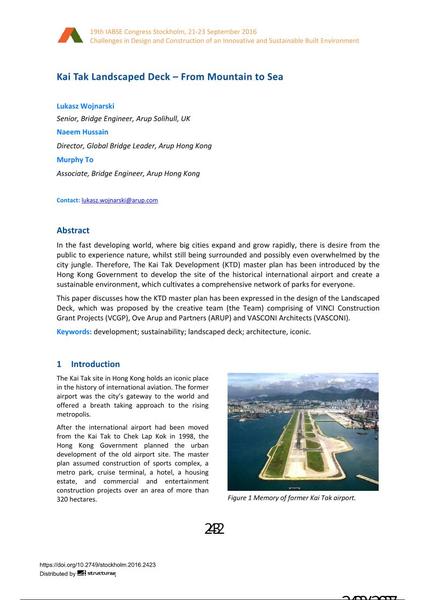Kai Tak Landscaped Deck – From Mountain to Sea

|
|
|||||||||||
Bibliografische Angaben
| Autor(en): |
Lukasz Leszek Wojnarski
(Senior, Bridge Engineer, Arup Solihull, UK)
Naeem Hussain (Director, Global Bridge Leader, Arup Hong Kong) Murphy To (Associate, Bridge Engineer, Arup Hong Kong) |
||||
|---|---|---|---|---|---|
| Medium: | Tagungsbeitrag | ||||
| Sprache(n): | Englisch | ||||
| Tagung: | IABSE Congress: Challenges in Design and Construction of an Innovative and Sustainable Built Environment, Stockholm, Sweden, 21-23 September 2016 | ||||
| Veröffentlicht in: | IABSE Congress Stockholm, 2016 | ||||
|
|||||
| Seite(n): | 2432-2438 | ||||
| Anzahl der Seiten (im PDF): | 7 | ||||
| Jahr: | 2016 | ||||
| DOI: | 10.2749/stockholm.2016.2423 | ||||
| Abstrakt: |
In the fast developing world, where big cities expand and grow rapidly, there is desire from the public to experience nature, whilst still being surrounded and possibly even overwhelmed by the city jungle. Therefore, The Kai Tak Development (KTD) master plan has been introduced by the Hong Kong Government to develop the site of the historical international airport and create a sustainable environment, which cultivates a comprehensive network of parks for everyone. This paper discusses how the KTD master plan has been expressed in the design of the Landscaped Deck, which was proposed by the creative team (the Team) comprising of VINCI Construction Grant Projects (VCGP), Ove Arup and Partners (ARUP) and VASCONI Architects (VASCONI). |
||||
| Stichwörter: |
Nachhaltigkeit Architektur Entwicklung
|
||||
